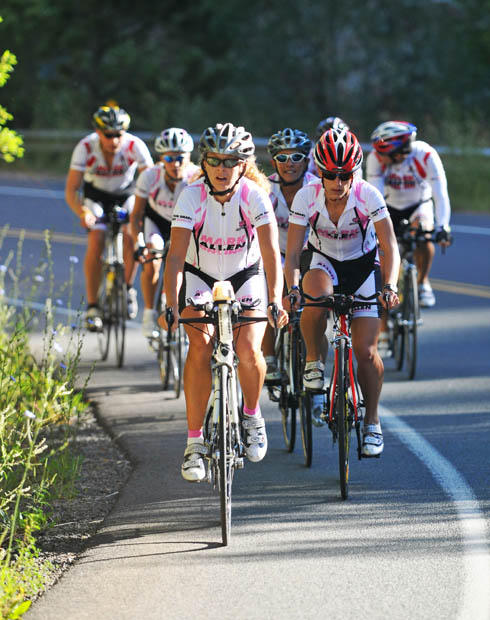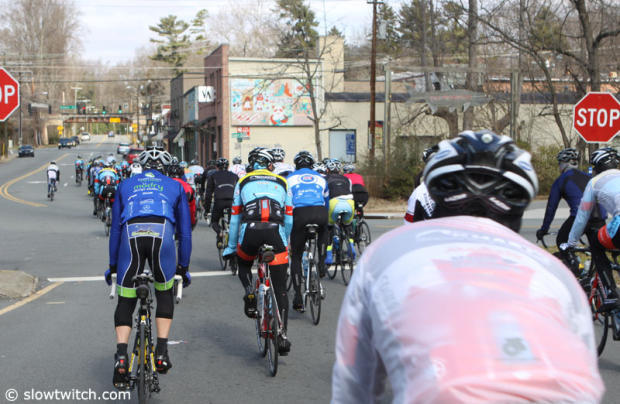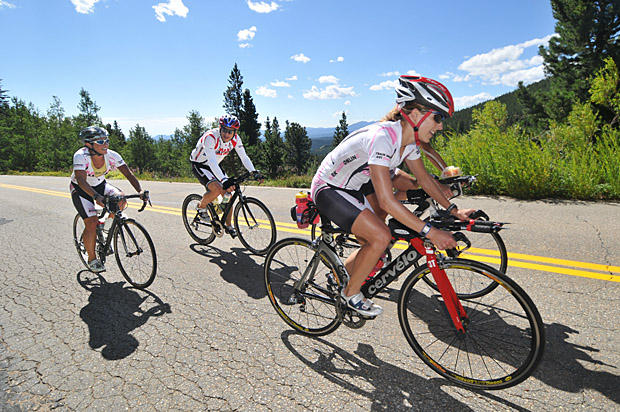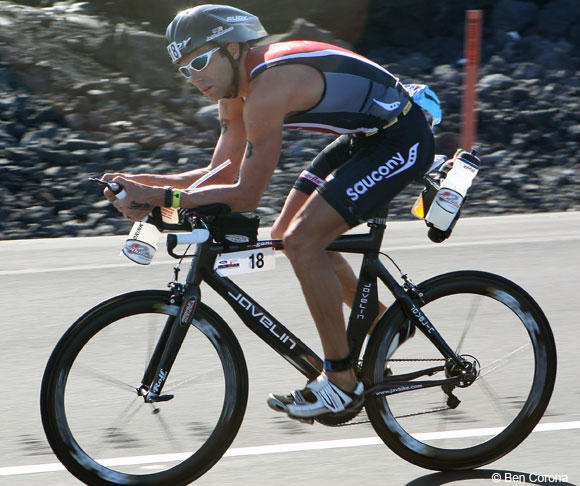Group Ride Etiquette
It's not that triathletes are boorish or selfish in their habits. Blissful is more like it. Blissfully unaware. The famous Underpants Run held annually in Kona pays homage to the Europeans (i.e., Finns) who, in Kona's early years, would walk through the produce section of the local Pay ‘N Save market in their brief briefs, blissfully unaware.
If your response to pushing a shopping cart through a supermarket in Speedos is, "What's your point?" then I rest my case.
Triathletes are ebullient, confident immigrants to new modes of endurance sport, dropping into a new activity like cycling with big engines but little appreciation for how things are done. Cycling (especially in groups) and swimming (especially on teams) come with their own rules. Etiquette. Most of these rules spring from a foundation of safety and group management. In cycling, it's entirely about safety.
The rules for group riding are sound and they ought to be honored in all groups, including groups consisting only of triathletes. But let's talk mostly about group rides typical of road cyclists.

When you first show up, best to arrive aboard your road race bike if you have one. Road cyclists aren't crazy about riding with you if you're on a tri bike, because they want your hands proximate to the controls. Also, of course, best if you don't advertise that you're a multisporter. Try to fit in. Be incognito.
It is also best not to demonstrate your strength; at least not for the first few rides. There is great utility in these group rides. Don't mess it up for yourself. If it's a group ride containing bike racers you won't need to wonder whether you'll get a good workout.
Positioning:
I always try to ride as close to the side of the road as makes sense. I think it's rude as well as dangerous to not ride as close as possible to the side of the road. I'm okay with riding 2-up, side-by-side (like in the image above), as long as the group moves to single file when a car approaches. If I'm riding into a headwind I almost always ride single-file, not just for the draft but because I can't hear a car coming up behind me.
Large groups of cyclists, even road riders, will often hog the road. Fine. They're going to do what they're going to do. I'm just not going to be one of them. I might ride the group ride, but I'll always be pretty close to the edge of the road. I not only feel that safety is a concern here, there's the consideration given to the drivers of cars. But mostly it's that half the peloton feels, as I do, that those riding out in the middle of the road are not following proper etiquette. If you're one of those riding out there, half the group will think you're a jerk, even if they don't say it.
Sometimes the ride isn't like this. Sometimes the ride is all over the lane. This is okay, perhaps, in a very rural area, with almost no cars on the road. Just use judgment.
While in the group:
Be a member of the marching band. Do what everybody else does. Try your hardest to be a member of the group, not an individual.
Now, if you're the last guy in the peloton, nobody behind you, do what you want. Ride naked. Spit. Ride no-hands. Weave all over the road. But if there's someone behind you – and you ought to ride as if there always is – you have a responsibility to a person who's putting his health in your hands.

This means holding your line (left to right), and holding your speed. It means no braking if you can help it, unless you're on a descent or approaching a turn. If you do brake, best if it's very gradual and subtle, not a sudden deceleration.
The rule of thumb here is: Be predictable. The very worst thing in a peloton is a surprise.
Don't get out of the saddle unless on a climb. If you stand, your bike stops briefly, and the person just behind you will run into you. Even on a climb, if someone is right on your wheel, try not to stop the bike as you raise out of the saddle. Try to come out of the saddle while keeping the bike moving at its rate of speed. Yes, this will take a little more effort, but, it's the courteous thing to do and it'll keep you from getting yelled at. And, again, do not get out of the saddle on the flats if there's somebody on your wheel.
When in front:
It's your responsibility, if you find yourself in front, not to alter the pace. Don't speed up when somebody pulls off and it's your turn to ride point. You must call out signs of danger, including road imperfections as well as obstacles. "Up" means in front, "back," means coming up from behind. So, "runner up" means there's a runner on the side of the road, the group is going to catch the runner. "Car up" means there's probably a parked car that the group will need to avoid. "Car back" means there's a car attempting to pass the group and, by god, move safely over to the side of the road (safely meaning without cutting off another cyclist).
Name the obstacle, and point to it. Bottle, cat, rock, pothole, curb. Point at it, and gently move to the side well before you come to it. If you're in the pack rather than leading it, you point to it as well.

When you're done with your pull, a flick of the elbow signals for the next rider to come through. Don't keep pedaling the same speed when you pull off. Don't make the rider behind you fight to gain the point. Don't pull off violently. Everything ought to be done predictably, gently, with the least amount of change of direction or speed possible.
How long should your pull be? Might be 10 seconds, might be 45 seconds. Depends on what the rest of the group is doing. Emulate what they are doing.
What if you think the group should be doing something differently? When should you impress your own will upon the group? When nothing you read here is new to you. When you are acknowledged by many in the group of being one of the leaders of the group.
Helmet:
Do not show up without a helmet. Even if you think you don't need a helmet. Even if you think it's an intrusion on your rights as an individual. Even if you think the science is flawed on seat belts and air bags and helmets. Even if you think it doesn't make any difference to anyone else whether or not you wear a helmet. It's bad etiquette to show up to a group ride without a helmet.
Turn signals:
Left hand turn is the left hand straight out to the side. Right hand turn is the left forearm to the side, but left arm straight up in the air, vertically. Signal multiple times when a turn approaches. But, if you're signaling so early that it's possible riders might take a turn before the turn you mean, be vociferous and obvious about where the actual turn is. Don't approach the turn at race pace. Give everybody a lot of opportunity to know what happens. No surprises.
[Point of order: Since the publication of this article there have been some complaints that a right hand turn should be signaled just via the right hand extended right. This is a perfectly acceptable convention. Both are acceptable. I often signal BOTH ways when I'm leading a ride. The point is to signal; signal obviously; signal both verbally and visually.]
Stops:
Like the image above, I default to whatever it is the group is doing. If they all stop and put a foot down at stop signs, I do too. If they roll the stops, I do too. I think it's best to trust the collective judgment of a group who's been riding the same ride or rides for a long time. I can't tell you how you should treat stops, that's just how I treat them. I roll stops if the group rolls them because of the riders behind me. There is also a hand signal for stopping: Left upper arm horizontal, forearm pointing straight down.
Getting dropped:
The thing about Slowtwitch, we have a tendency to use swim phrases in running, running in cycling, and cycling phrases for just about everything. One I fall back on is, "It's your gap to close." In cycling it means that if you let a gap open up between you and the rider in front of you, it's your duty to close it back up because of the riders behind you who're relying on everyone to keep the pack together. Me, I think the phrase is just perfect for all kinds of situations, in and out of athletics. If you let down your responsibility to the group, well, it's your gap to close. You need to fix it.

While that's the case, if it's a hard-charging peloton, sometimes people get dropped. If you know that's going to happen, you need at least to let the group know this is going to happen, so that they have a chance at latching on. So, before you get really dropped, waive the group on by.
Echelon:
This is a tricky one. What about during sidewinds? The group will want to echelon, with front wheels overlapping back wheels. Be very careful with this. If the rider in front doesn't know you're overlapped, he might swerve, and one of you (at least) will go down. Plus the riders behind you. If the wind is coming from the right (and you're riding in North America), the front wheels of bikes behind might be overlapped to the left of the rear wheel of the bike in front. In this case, best for the leading rider to drop straight back rather than pull off to the left of the paceline. If the rider pulls to the left, and the rider behind him is overlapped, down goes a number of riders.
After a pull:
The one time when I think it is okay to get out of the saddle on the flats, in a group, is when you've pulled off, you've taken your pull, you've drifted back to the last rider in the paceline, and I'll often get out of the saddle to get up to speed. I might get out of the saddle before I'm behind the last rider, so that when he goes by me I slot right in. Realize that in this case there is no rider behind me, so I'm not imperiling anybody.
Group leader:
I've had occasion to ride with some very good group leaders. If you find yourself in this position, be forceful. Don't be a jerk, but try in a nice way to exert your will, for the sake of safety and courtesy to drivers. If there's a stretch of road that needs to be ridden single-file or 2-up, explain that to the group, hopefully first before the ride starts, and then again when you reach that stretch.

Group leaders will need to look back occasionally, if they're in front, to make sure the group is keeping up, to make sure the group is not blocking traffic. Looking back is very tricky on a bike. It takes a long time before a rider is practiced enough to look back without veering/steering in the direction he's craning his neck. Some of the good group leaders I've seen will, if they're riding 2-up, place a hand on the back of the rider next to him while he's looking back, to both as a cue to himself and as a warning to the rider next to him if he does begin to unwittingly steer offline.
[Point of order: After publication of this article some observers felt that it should be strongly stated that one rider touching another is verboten group riding. Very true. Some even question the sole example of mine above where one rider touching another can be appropriate.]
Expectorating:
Obviously, watch where you spit. Or whatever it is you're leaving behind. If I'm in a group and I've got to eject some spit, snot, whatever, I'll often just let heave right into my jersey sleeve. You've got to wash the jersey anyway.
Aerobars:
I've ridden with groups of triathletes who ride the group ride in their aerobars. If that's what the group is comfortable doing, no problem. I used to ride with a 4-man group every week, and it was just an all-out TTT for 25 miles. We rode inches from the rear wheel in front of us the whole ride, in our aerobars the whole way. And that's fine, if that's the expectation of the group, and the group knows what it's doing. But if this is a group ride with which you're unfamiliar, especially if it includes road cyclists on road bikes, it's borderline bad form to show up with a tri bike, and additional bad form to ride in the aero bars unless you're in first or last place in that peloton.
Have fun:
Group rides are highlights of the week. But whether it's a group of roadies or a masters swim team, you'll want to introduce yourself, make friends, but realize these groups are often wary of strangers because they've seen a lot of newcomers who do not observe etiquette. It won't take you long before you're one of the pack, just be inconspicuous, and impress them with your ability to keep both you and them safe.






Start the discussion at forum.slowtwitch.com